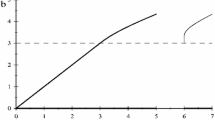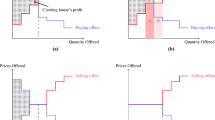Abstract
We analyze the two-stage games induced by competitive equilibrium rules for the buyer–seller market of Shapley and Shubik (Int J Game Theory 1:111–130, 1972). In these procedures, first sellers and then buyers report their valuation and the outcome is determined by a competitive equilibrium outcome for the market reported by the agents. We provide results concerning buyers and sellers’ equilibrium strategies. In particular, our results point out that, by playing first, sellers are able to instigate an outcome that corresponds to the sellers’ optimal competitive equilibrium allocation for the true market.
Similar content being viewed by others
Notes
Demange and Gale (1985) extend the theorem to a model where the utilities are continuous in money, but are not necessarily linear. Pérez-Castrillo and Sotomayor (2013) prove that buyers (respectively, sellers) do not have an incentive to misreport their valuation if the buyer-optimal (respectively, seller-optimal) competitive equilibrium is used by the designer in a one-to-many (respectively, many-to-one) buyer–seller market.
Papers analyzing the consequences of manipulation in marriage and the college admission models, that is, in models where there are no prices, include Gale and Sotomayor (1985a, (1985b), Roth (1985), Roth and Sotomayor (1990), Sotomayor (2008), Kojima and Pathak (2009), Ma (2010), Sotomayor (2012), and Jaramillo et al. (2013).
Tie breaking rules are common in mechanism design. See, for instance, Pérez-Castrillo and Sotomayor (2002) for the assignment game. Some papers use alternatives to tie breaking rules to ensure existence of equilibria. For instance, for the combinatorial assignment problem where monetary transfers are not allowed, Budish (2011) proposes the use of “approximate competitive equilibrium” notions.
See Roth and Sotomayor (1990) for an overview of this model.
We use the notation \(\sum _{j}\) for the sum over all \(b_{j}\) in \(B,\,\sum _{k}\) for the sum over all \(s_{k}\) in S and \(\sum _{j,k}\) for the sum over all \(b_{j}\) in B and \(s_{k}\) in S.
This result was also proved in Sotomayor (2000) by using combinatorial arguments.
The definition of \(\sigma (r^{\prime } )\) implies that the buyers can signalize any optimal matching x for \(M(a^{\prime } (r^{\prime } ),\,r^{\prime } )\) by choosing \(\sigma (r^{\prime } ) =\,x\). More generally, they can signalize any subset S of optimal matchings for \(M(a^{\prime } (r^{\prime } ),\,r^{\prime } )\) by selecting \(\sigma _{jk}(r^{\prime } ) = 1\) if there is some matching x in S such that \(x_{jk}\,= 1\) and \(\sigma _{jk}(r^{\prime } ) = 0\) otherwise.
We can also consider that each matching in this set has the same probability of being selected.
We write \(a_{-j}^{\prime }\) to denote the decision profile for the buyers other than \(b_{j}\).
References
Alcalde, J., Pérez-Castrillo, D., Romero-Medina, A.: Hiring procedures to implement stable allocations. J. Econ. Theory 82, 469–480 (1998)
Budish, E.: The combinatorial assignment problem: approximate competitive equilibrium from equal incomes. J. Polit. Econ. 119, 1061–1103 (2011)
Demange, G.: Strategyproofness in the assignment market game. Preprint. École Polytechnique, Laboratoire d’Économetrie, Paris (1982)
Demange, G., Gale, D.: The strategy structure of two-sided matching markets. Econometrica 55, 873–88 (1985)
Gale, D.: The Theory of Linear Economic Models. McGraw Hill, New York (1960)
Gale, D., Sotomayor, M.: Ms. Machiavelli and the stable matching problem. Am. Math. Mon. 92, 261–268 (1985a)
Gale, D., Sotomayor, M.: Some remarks on the stable matching problem. Discret. Appl. Math. 11, 223–232 (1985b)
Hayashi, T., Sakai, T.: Nash implementation of competitive equilibria in the job-matching market. Int. J. Game Theory 38, 453–467 (2009)
Jaramillo, P., Kayi, C., Klijn, F.: Equilibria under deferred acceptance: dropping strategies, filled positions, and welfare. Games Econ. Behav. 82, 693–701 (2013)
Kamecke, U.: Non-cooperative matching games. Int. J. Game Theory 18, 423–431 (1989)
Kelso, A., Crawford, V.P.: Job matching, coalition formation, and gross substitutes. Econometrica 50, 1483–1504 (1982)
Kojima, F., Pathak, P.A.: Incentives and stability in large two-sided matching markets. Am. Econ. Rev. 99, 608–627 (2009)
Leonard, H.B.: Elicitation of honest preferences for the assignment of individuals to positions. J. Polit. Econ. 91, 461–479 (1983)
Ma, J.: The singleton core in the hospital-admissions problem and its application to the National Resident Matching Program (NRMP). Games Econ. Behav. 69, 150–164 (2010)
Pérez-Castrillo, D., Sotomayor, M.: A simple selling and buying procedure. J. Econ. Theory 103, 461–474 (2002)
Pérez-Castrillo, D., Sotomayor, M.: On the manipulability of competitive equilibrium rules in many-to-many buyer–seller markets. W.P, BGSE (2013)
Roth, A.: The college admissions problem is not equivalent to the marriage problem. J. Econ. Theory 36, 277–288 (1985)
Roth, A., Sotomayor, M.: Two-sided matching. A study in game-theoretic modeling and analysis. Econometric Society Monograph Series, vol. 18, Cambridge University Press, Cambridge (1990)
Shapley, L., Shubik, M.: The assignment game I: the core. Int. J. Game Theory 1, 111–130 (1972)
Sotomayor, M.: On incentives in a two-sided matching market. Pontificia Universidade Católica do Rio de Janeiro, W.P. Department of Mathematics (1986)
Sotomayor, M.: Existence of stable outcomes and the lattice property for a unified matching market. Math. Soc. Sci. 39, 119–132 (2000)
Sotomayor, M.: A simultaneous descending bid auction for multiple items and unitary demand. Rev. Bras. Econ. 56, 497–510 (2002)
Sotomayor, M.: Connecting the cooperative and competitive structures of the multiple-partners assignment game. J. Econ. Theory 134, 155–74 (2007)
Sotomayor, M.: Admission games induced by stable matching rules. Int. J. Game Theory 36, 621–640 (2008)
Sotomayor, M.: A further note on the college admission game. Int. J. Game Theory 41, 179–193 (2012)
Acknowledgments
We thank three reviewers and an Associate Editor for very helpful comments. Marilda Sotomayor is a research fellow at CNPq-Brazil. David Pérez-Castrillo is a fellow of MOVE and CESIfo. He acknowledges financial support from the Ministerio de Ciencia y Tecnología (ECO2015-63679-P), Generalitat de Catalunya (2014SGR-142), the Severo Ochoa Programme for Centres of Excellence in R&D (SEV-2015-0563) and ICREA Academia.
Author information
Authors and Affiliations
Corresponding author
Rights and permissions
About this article
Cite this article
Pérez-Castrillo, D., Sotomayor, M. The outcome of competitive equilibrium rules in buyer–seller markets when the agents play strategically. Econ Theory 64, 99–119 (2017). https://doi.org/10.1007/s00199-016-0997-9
Received:
Accepted:
Published:
Issue Date:
DOI: https://doi.org/10.1007/s00199-016-0997-9




